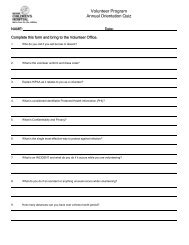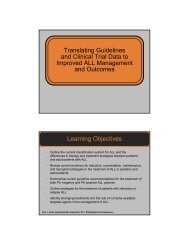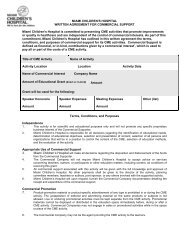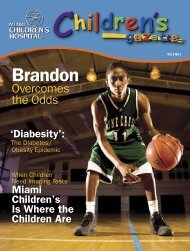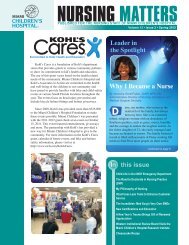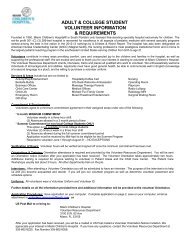Implantation of the Melody Transcatheter Pulmonary Valve - Miami ...
Implantation of the Melody Transcatheter Pulmonary Valve - Miami ...
Implantation of the Melody Transcatheter Pulmonary Valve - Miami ...
You also want an ePaper? Increase the reach of your titles
YUMPU automatically turns print PDFs into web optimized ePapers that Google loves.
JACC Vol. 54, No. 18, 2009October 27, 2009:1722–9Zahn et al.Early Results From <strong>the</strong> Transca<strong>the</strong>ter <strong>Pulmonary</strong> <strong>Valve</strong> Trial1725Clinical Characteristics <strong>of</strong> Study Patients (n 34)Table 4 Clinical Characteristics <strong>of</strong> Study Patients (n 34)Variable/CategoryWeight, kg 61.1 15.3SexMale 26 (77)Female 8 (23)Age, yrs 19.4 7.7Original diagnosisTetralogy <strong>of</strong> Fallot 18 (52)Truncus arteriosus 4 (12)Aortic valve disease (Ross procedure) 4 (12)Transposition <strong>of</strong> <strong>the</strong> great arteries 3 (9)O<strong>the</strong>r 5 (15)NYHA functional classificationI 6 (18)II 23 (67)III 5 (15)IV 0 (0)RVOT conduit typeHomograft 27 (79)Biologic valved conduit 3 (9)O<strong>the</strong>r* 4 (12)RVOT conduit size 20.0 2.1Primary indication for implantationStenosis 6 (18)Regurgitation 23 (67)Mixed stenosis and regurgitation 5 (15)Pre-existing stents in RVOT conduitNo pre-existing stents in RVOT conduit 19 (56)Single stent in RVOT conduit 12 (35)Multiple stents in RVOT conduit 3 (9)Number <strong>of</strong> previous open surgeries 2.2 1.0PR by echocardiographyNone 0 (0)Trace 0 (0)Mild 1 (3)Moderate 12 (35)Severe 20 (59)Unable to assess 1 (3)Average conduit Doppler mean gradient (mm Hg) 28.4 11.4Data are presented as mean SD for continuous data or n (%) <strong>of</strong> subjects for categorical data.*O<strong>the</strong>r conduit types were nonvalved “tube grafts,” nonvalved homograft, and biopros<strong>the</strong>sis.Abbreviations as in Table 1.discharged within 7 days. Criteria for procedural successwere met in 93% (28 <strong>of</strong> 30) <strong>of</strong> attempted implantations. Inaddition to <strong>the</strong> patient with conduit rupture, <strong>the</strong> o<strong>the</strong>rpatient categorized as a procedural failure had a postimplantationRV-PA peak gradient <strong>of</strong> 37 mm Hg. Thegradient across <strong>the</strong> <strong>Melody</strong> valve was only 5 mm Hg, but<strong>the</strong>re was subvalvar muscular obstruction, which resulted in<strong>the</strong> elevated RV-PA gradient. In subsequent follow-up, thispatient’s conduit Doppler mean gradient was consistently25 mm Hg, and no fur<strong>the</strong>r intervention was performed.Short-term effectiveness. In terms <strong>of</strong> <strong>the</strong> short-term effectivenesscriteria defined in Table 3, 29 patients retained<strong>the</strong> <strong>Melody</strong> valve at 24 h, and 24 (83%) had acceptablehemodynamics at <strong>the</strong> 6-month time point. Follow-up dataare presented for <strong>the</strong> 29 patients who retained a <strong>Melody</strong>valve at 24 h.ACUTE HEMODYNAMIC RESULTS. After valve implantation,RV systolic pressure, RV-PA gradient, and <strong>the</strong> RV/aorticpressure ratio were significantly lower, and <strong>the</strong> PA diastolicpressure was significantly higher than before implantation(Table 5). Pre-discharge echocardiography demonstrated noPR or trivial PR in 86% <strong>of</strong> patients and mild PR in 14%.CLINICAL ASSESSMENT. NYHA functional class improvedafter <strong>Melody</strong> valve implantation (Fig. 1). Of 24 patientswho were NYHA functional class II or III before implantation,19 (79%) had an improvement <strong>of</strong> at least 1 class; nopatient experienced a decline in NYHA functional class.ECHOCARDIOGRAPHY. <strong>Valve</strong> competence was maintainedduring follow-up, with 93% <strong>of</strong> patients having no/trivialPR and no patient having more than mild PR 6 monthsafter implantation. Improvement <strong>of</strong> conduit obstructionwas maintained for <strong>the</strong> group as a whole, with averageDoppler mean gradient improving from 28.8 10 mmHg before implantation to 22.4 8.1 mm Hg at 6months (p 0.001). Five patients had Doppler meangradients 30 mm Hg at 6-month follow-up. One <strong>of</strong><strong>the</strong>se patients had a major stent fracture and underwent asuccessful second <strong>Melody</strong> valve implantation, 1 hadasymmetric expansion <strong>of</strong> <strong>the</strong> <strong>Melody</strong> valve and wastreated successfully using high-pressure balloon angioplasty,1 was discovered at subsequent ca<strong>the</strong>terization tohave obstruction below <strong>the</strong> conduit, 1 had stent fracturebut had not undergone repeat ca<strong>the</strong>terization, and in 1patient <strong>the</strong>re was no obvious explanation. All 5 were inNYHA functional class I at most recent follow-up.cMRI. Twenty-five patients (83%) had paired cMRI databefore and 6 months after implantation (Table 6). Significantreductions in PR fraction and RV end-diastolic volumewere seen. The median PR fraction was 3.1% at 6 monthsAcute Hemodynamic Ca<strong>the</strong>terization Data (n 29)Table 5 Acute Hemodynamic Ca<strong>the</strong>terization Data (n 29)Variable Pre-<strong>Implantation</strong> Post-<strong>Implantation</strong> p ValueRV systolic pressure, mm Hg 67.7 16.1 (68; 32–108) 48.9 13.7 (46; 26–82) 0.001RV/aortic systolic pressure ratio 0.7 0.2 (0.7; 0.3–1.0) 0.4 0.1 (0.4; 0.3–0.75) 0.001RV-PA gradient, mm Hg 37.2 16.3 (39; 9–69) 17.3 7.3 (18; 5–37) 0.001PA diastolic pressure, mm Hg 11.0 5.2 (10; 1–28) 14.7 5.1 (15; 4–28) 0.001Data are presented as mean SD (median; minimum–maximum).Abbreviations as in Table 3.



